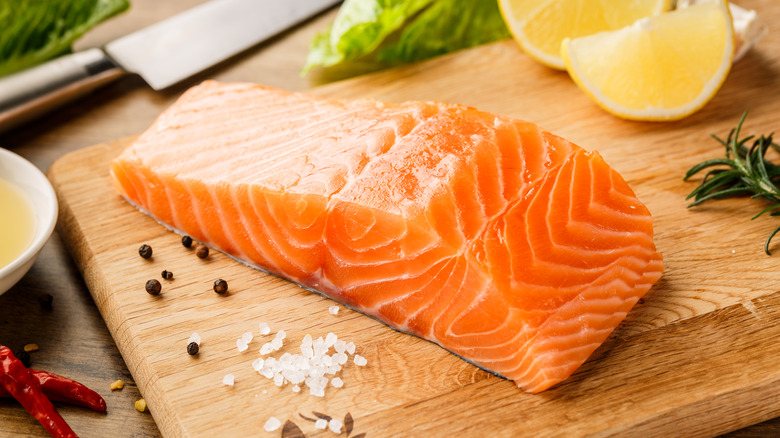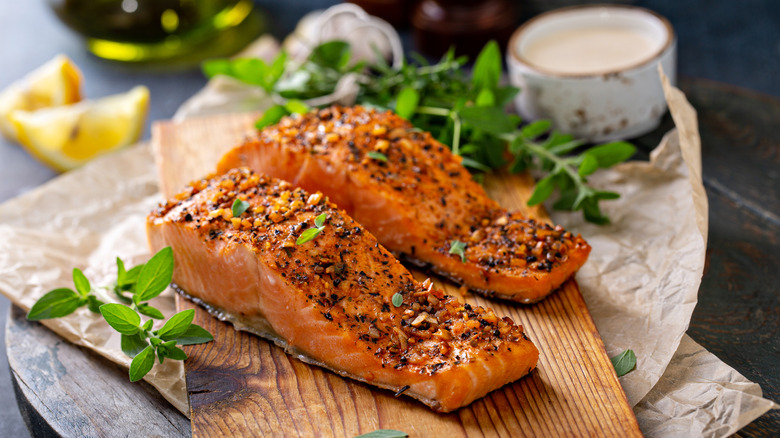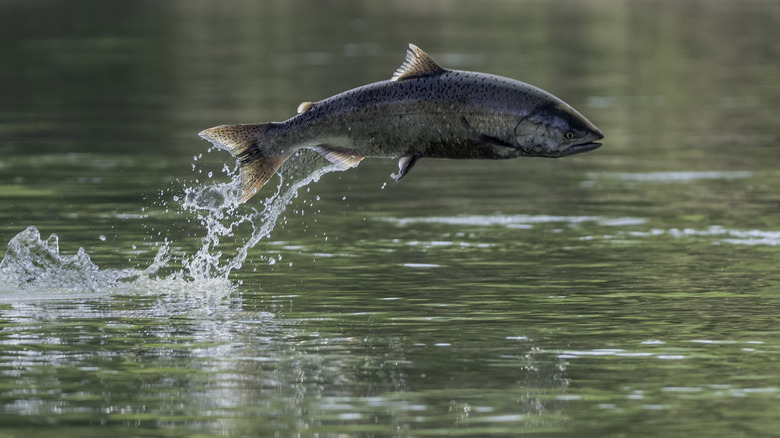Pacific And Atlantic Salmon Have Some Key Differences You Should Know
Where your salmon comes from can play an important role in your enjoyment of the meal. Different types of salmon can have different tastes and textures, so it's important to pay attention to what kind of fish you're buying.
The biggest difference between Atlantic and Pacific salmon is not actually where it comes from. Rather, the terms refer to the species of fish. Atlantic salmon is a species that is pretty commonly found for sale, mainly because it is farmed all over the world. It is light pink in color thanks to its fat content, and it's soft when bitten into.
Pacific salmon, on the other hand, refers to a family of fish that encompasses the chinook, sockeye, coho, pink, and chum salmon species that are all found in the Pacific Ocean. These fish are usually darker red in color, leaner in fat, and have a firmer feel. Pacific salmon are usually not raised in farms but are instead caught in the wild.
The flavors of the fish differ
There are differences between the salmon species when it comes to taste, too. Although both types of fish will have that distinctive salmon flavor, there will be flavor differences obvious to those who frequently enjoy the fish. Atlantic salmon has a pretty mild flavor and pairs well with other ingredients in plenty of dishes — like this pesto-baked salmon recipe.
Pacific salmon has a little more intense flavor. Depending on the variety, its taste can range from buttery to stronger and bolder. Because of this more intense flavor, it may be best served in dishes where the fish's natural flavors are allowed to be the main focus.
There are nutritional differences between the salmon types, too. While both are considered pretty heart-healthy, Healthline reports that Atlantic salmon is a little higher in fat, though it has just a tiny bit more protein. Pacific salmon, on the other hand, is higher in calcium, iron, and cholesterol. And while both varieties contain Omega-3, Atlantic salmon has a higher concentration of the essential fatty acids (via The Heart Dietician).
Some salmon can only be found seasonally
Since Atlantic salmon is farmed year-round, it is more commonly available than Pacific varieties. Pacific salmon fans will need to wait until spawning season to cook up the fresh fish — and depending on your preferred species, you could have a pretty small window of time to snag some.
The earliest found Pacific variety is the chinook salmon, which can be purchased fresh between the end of April to late June. Sockeye makes its appearance mid-summer, from June to July. Pink salmon is found in late summer, from August to September. And Coho salmon is found into the fall, from late July to October. Chum salmon, meanwhile, could be more commonly found. It is typically used for canning, so it can be preserved and sold in stores no matter the season.
Because of the greater availability, Atlantic salmon is generally a little bit cheaper to purchase. Shoppers can find the fish for roughly $10 to $15 per pound. Pacific salmon, meanwhile, could cost up to $25 per pound.


